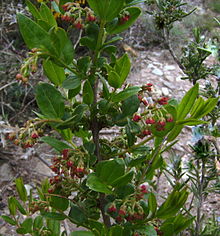- Coriaria myrtifolia
-
Coriaria myrtifolia Leaves and mature fruits in July Scientific classification Kingdom: Plantae (unranked): Angiosperms (unranked): Eudicots (unranked): Rosids Order: Cucurbitales Family: Coriariaceae Genus: Coriaria Species: C. myrtifolia Binomial name Coriaria myrtifolia
L.Coriaria myrtifolia, called in English redoul, is a shrub to 2–3 m tall. Myrtifolia means myrtle-like leaves. The fruit is a fleshy black berry achene slightly similar to a blackberry but toxic. Coriaria myrtifolia has the largest fruits in the genus Coriaria.[1] It is especially dangerous for children, who may eat it if they confuse it with edible berries. Coriaria myrtifolia should be recognized as one of the most neurotoxic plants in western Mediterranean area.[2]
Contents
Range
Geographically, this species is confined to the northern Mediterranean coastal Spain and Southern France (from the Gironde to the Alpes Maritimes), penetrating into Italy as far as part of the Apennines, the species reappears in the western Rif and Algeria,in the Balearic islands it appears only in Ibiza.[3] The oldest known mention of this plant, dating from 932, is in a place name and implies its presence in the County of Manresa, north-west of Barcelona.[4]
In all this range plays an important role against soil erosion and serves as understory vegetation. Is extraordinarily abundant in the less dense woodlands of the Spanish provinces of Girona and Barcelona (eastern part) at altitudes of 200–600 m., reaching occasionally to 1,000.[5]
Name
The Spanish name emborrachacabras (i.e. getting goats drunk) refers to the leaves' effect on goats that eat them. The French name (redoul) and Catalan name (roldor) derive from Latin Rhus tyrius (Syrian or Tyrian sumac), referring to the leaves use in the traditional tannery industry.
Description
The root nodules of this plant make symbiotic nitrogen fixation,[6]Coriaria myrtifolia is one of the 13 Coriaria species known to bear actinorhizae[7]
The Redoul is a shrub with branches greyish square section. The leaves are sessile, mostly opposite but sometimes in groups of three or more, oblong, acuminate, three ribs. The small greenish flowers, appear from April to June in racemes, have five reddish highlights styles, five sepals and five petals, with ten stamens. The black fruits are formed of five fleshy carpels, each containing one seed.
Toxicity
Leaves and fruits contain coriamyrtin a typical convulsant substance[8] one member of picrotoxane sesquiterpenes, was first isolated in 1864.[9] Toxic effects are characterized by digestive (nausea, vomiting, abdominal pain), neurological (obnubilation, convulsions and their complications), and respiratory disorders (polypnea, respiratory problems, apnea, short and superficial respiration) together with myositis of the pupils. Treatment of this poisoning is purely symptomatic. In the case of convulsions, rapid resuscitation in an intensive care unit is necessary. Coriamyrtin have also pharmacological action.[10]
The honeydew from redoul is also toxic.[11]
Uses
Traditionally leaves of redoul were intensively collected for his tannins content for tanning and dyeing purposes. During medieval period ecclesiastical institutions, lords, royalty have clearly sought to establish some royalties on that resource, the samples are being especially on the distribution and sale of material first. These uses are due to the wealth of Coriaria spp tannin, particularly concentrated in the stem bark and root, but also present in leaves, where they coexist with yellow dyes chemical group of flavonoids. These tannins are part of the group of hydrolyzable tannins, such as gall tannins. The chemical composition of redoul thus makes a tanning substance, capable of transforming animal skins recently flayed leather, material rot resistant, flexible and relatively impermeable, a widespread use in many industries. Moreover, the well known chemical reaction of tannins with iron salts, producing black precipitates, is the basis for the manufacture of some inks used since the Middle Ages and is also used to dye it black or gray variety of textiles. Until the mid-fourteenth century, the material was the subject of extensive trade between the north of Catalonia and Languedoc.[12]
It is also used as an ornamental plant.[13]
References
- ^ http://www.springerlink.com/content/g2urn5665653rkj4/
- ^ http://www.sciencedirect.com/science?_ob=ArticleURL&_udi=B6TCS-4H3BKVN-1&_user=10&_coverDate=11%2F30%2F2005&_rdoc=1&_fmt=high&_orig=search&_origin=search&_sort=d&_docanchor=&view=c&_searchStrId=1625773327&_rerunOrigin=scholar.google&_acct=C000050221&_version=1&_urlVersion=0&_userid=10&md5=13f7ccfb150d375af98eab307afbbd1b&searchtype=a
- ^ http://www.nature.com/nature/journal/v182/n4633/abs/182475a0.html
- ^ « In comitatum Manresa, in terminio de Kastro Rosetorium... », F. Udina Martorell, El Archivo condal de Barcelona en los siglos ix-x. Estudio crítico de sus fondos, Barcelona, 1951, p. 204, § 104.
- ^ http://www.nature.com/nature/journal/v182/n4633/abs/182475a0.html
- ^ http://www.nature.com/nature/journal/v193/n4820/abs/1931103a0.html#References
- ^ http://md1.csa.com/partners/viewrecord.php?requester=gs&collection=ENV&recid=1925382&q=Coriaria+myrtifolia&uid=790317218&setcookie=yes
- ^ http://jpet.aspetjournals.org/content/57/4/410.abstract
- ^ http://pubs.acs.org/doi/abs/10.1021/ja00382a047
- ^ . PMID 12422481.
- ^ http://www.jstor.org/pss/2482183
- ^ http://medievales.revues.org/3443?&id=3443
- ^ http://www.mapa.es/ministerio/pags/biblioteca/revistas/pdf_hortint/hortint_2004_46_62_67.pdf
Sources of condensed tannins Areca catechu seed (arecatannins) | Broad bean (Vicia faba) | Grape (Vitis vinifera) | Quebracho wood | Mimosa bark (Acacia mollissima) | Myrtan or black marlock (Eucalyptus redunca)Sources of hydrolysable tannins Chestnut wood | Dhawa (Anogeissus latifolia) | Myrobalan fruit (Terminalia chebula) | Oak wood, bark or acorn cup (Valonea Quercus macrolepis) | Sumac (Tanner's sumach leaves - Rhus coriaria or Chinese gall on Rhus chinensis) | Tara pod (Caesalpinia spinosa)Other sources Alder (Alnus sp) | Avaram (Senna auriculata) | Babul (Acacia nilotica) | Birch (Betula sp) | Larch (Larix sp) | Hemlock (Tsuga sp) | mangrove | Pine (Pinus sp) | Spruce (Picea sp) | Urunday (Myracrodruon urundeuva) | Willow (Salix caprea)Badan (Bergenia crassifolia) | Gambier (Uncaria gambir) | Redoul (Coriaria myrtifolia)Cutch (Acacia catechu)Divi-divi pod (Caesalpinia coriaria) | Sant pod (Acacia nilotica) | Teri pod (Caesalpinia digyna)Gall oak (Quercus lusitanica)Whole plantProsopis sp. bark and wood (eg Prosopis humilis or Algarrobilla) | Tanoak (Lithocarpus densiflorus) | Tizra heartwood and root (Rhus pentaphylla)Misc Categories:- Cucurbitales
- Medicinal plants
- Poisonous plants
Wikimedia Foundation. 2010.


